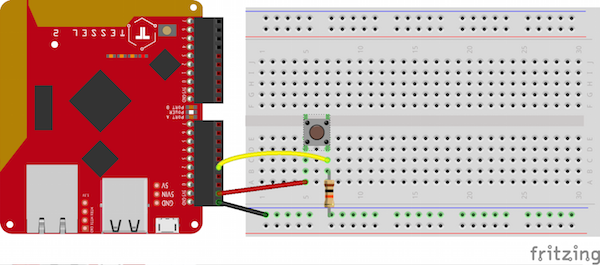Interrupts allow us to register events based on state changes in a pin. Pins 2, 5, 6, 7 on both Ports are available for interrupts.
Take a look at the following circuit. While the switch is open, pin2 will be low. When the button is pressed we’ll complete the circuit and the voltage at pin2 will rise to 3.3V.

Let’s turn on the green LED when the button is pressed. Here’s one way of doing it.
var tessel = require('tessel'); // Import tessel
// Initialize our pins
var green = tessel.led[2];
var pin2 = tessel.port.A.pin[2];
// Turn off the green LED
green.off();
// Every 10 milliseconds check to see if the button was pressed
setInterval(function() {
pin2.read(function(error, value) {
// button was pressed
if (value === 1) {
green.on();
}
});
}, 10);
This is pretty inefficient. We’re spending a lot of time (every 10 millseconds) manually checking to see if the button was pressed. Let’s just tell the processor to run some code when the voltage rises.
var tessel = require('tessel'); // Import tessel
// Initialize our pins
var green = tessel.led[2];
var pin2 = tessel.port.A.pin[2];
// Turn off the green LED
green.off();
// Register an event. When the voltage on pin2 rises, turn on the green LED.
pin2.on('rise', function() {
green.on();
});We tell the processor to invoke our callback function when pin2 rises (button has been pressed). We don’t have to continuously poll to see if the voltage has risen. We can just register our listener and move on.
